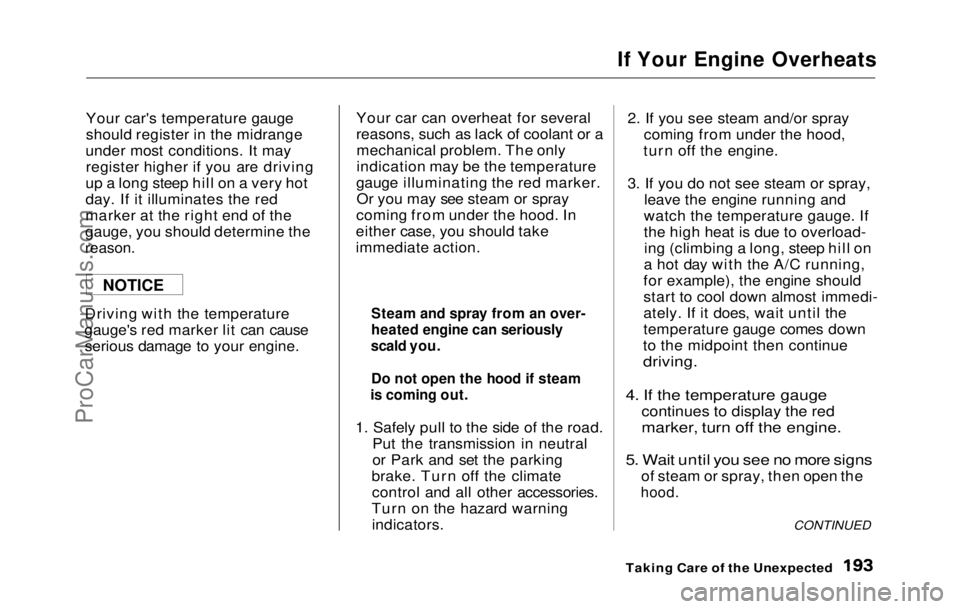Page 1 of 225

1992 Prelude Online Reference Owner's Manual
Use these links (and links throughout this manual) to navigate through\
this reference.
For a printed owner's manual, click on authorized manuals or go to www.h\
elminc.com.
Contents
Owner's Identification Form
Introduction ........................................................................\
................................................................. i
A Few Words About Safet y........................................................................\
.........................................ii
Driver and Passenger Safety ........................................................................\
......................................3
Proper use and care of your vehicle's seat belts, and Supplemental Restr\
aint System.
Instruments and Controls........................................................................\
.........................................29
Instrument panel indicator and gauge, and how to use dashboard and steering colu\
mn controls.
Comfort and Convenience Features ........................................................................\
...................... 67
How to operate the climate control system, the audio system, and other c\
onvenience features.
Before Driving........................................................................\
.......................................................... 97
What gasoline to use, how to break-in your new vehicle, and how to load luggage and other cargo.
Driving ........................................................................\
......................................................................107
The proper way to start the engine, shift the transmission, and park, pl\
us towing a trailer.
Maintenance........................................................................\
.............................................................127
The Maintenance Schedule shows you when you need to take your vehicle to the dealer.
Appearance Care........................................................................\
......................................................175
Tips on cleaning and protecting your vehicle. Things to look for if your\
vehicle ever needs body repairs.
Taking Care of the Unexpected........................................................................\
..............................183
This section covers several problems motorists sometimes experience, and how to handle them.
Technical Information........................................................................\
.............................................203
ID numbers, dimensions, capacities, and technical information.
Warranty and Customer Relations (U.S. and Canada)................................................................215
A summary of the warranties covering your new Acura, and how to contact \
us.
Authorized Manuals (U.S. only)........................................................................\
..............................221
How to order manuals and other technical literature.
Index ........................................................................\
........................ ......................................................
I
Gas Station Information
A summary of information you need when you pull up to the gas pump.
ProCarManuals.com
Page 189 of 225

If Your Engine Overheats
Your car's temperature gauge
should register in the midrange
under most conditions. It may register higher if you are driving
up a long steep hill on a very hot
day. If it illuminates the red
marker at the right end of the
gauge, you should determine the
reason.
Driving with the temperature
gauge's red marker lit can cause serious damage to your engine. Your car can overheat for several
reasons, such as lack of coolant or a
mechanical problem. The only
indication may be the temperature
gauge illuminating the red marker. Or you may see steam or spray
coming from under the hood. In
either case, you should take
immediate action.
1. Safely pull to the side of the road.
Put the transmission in neutral
or Park and set the parking
brake. Turn off the climate control and all other accessories.
Turn on the hazard warning indicators.
2. I f
you see steam and/or spray
coming from under the hood,
turn off the engine.
3. If you do not see steam or spray,
leave the engine running and
watch the temperature gauge. If
the high heat is due to overload- ing (climbing a long, steep hill on
a hot day with the A/C running,
for example), the engine should
start to cool down almost immedi-
ately. If it does, wait until the
temperature gauge comes down
to the midpoint then continue
driving.
4. If
the temperature gauge
continues to display the red
marker, turn off
the
engine.
5. Wait until you see no more signs
of steam or spray, then open the
hood.
Taking Care of the Unexpected
NOTICE
Steam and spray from an over-
heated engine can seriously
scald you.
Do not open the hood if steam
is coming out.
CONTINUEDProCarManuals.comMain Menu Table of Contents s t
Page 207 of 225

Emission Controls
The burning of gasoline in your
car's engine produces several by-
products. Some of these are carbon
monoxide (CO), oxides of nitrogen
(NOx) and hydrocarbons (HC).
Gasoline evaporating from the tank
also produces hydrocarbons. Con-
trolling the production of NOx, CO,
and HC is important to the environ-
ment. Under certain conditions of
sunlight and climate, NOx and HC
react to form photochemical "smog."
Carbon monoxide does not contri-
bute to smog creation, but it is a
poisonous gas.
The Clean Air Act
The United States Clean Air Act*
sets standards for automobile
emissions. It also requires that
automobile manufacturers explain
to owners how their emission
controls work and what to do to
maintain them. This section
summarizes how the emission con-
trols work. Scheduled maintenance
is on page 129 .
* In Canada, Honda vehicles
comply with the Canadian Motor
Vehicle Safety Standards (CMVSS)
for Emissions valid at the time they
are manufactured.
Crankcase Emission Control
System
Your car has a Positive Crankcase
Ventilation (PCV) System. This
keeps gasses that build up in the engine's Crankcase from going into
the atmosphere. The PCV valve
routes them from the crankcase
back to the intake manifold. They
are then drawn into the engine and
burned.
Evaporative Emission
Control SystemAs gasoline evaporates in the fuel
tank, a canister filled with charcoal
adsorbs the vapor. It is stored in
this canister while the engine is off.
After the engine is started and
warmed up, the vapor is drawn into the engine and burned during
driving.
Technical Informatio n
ProCarManuals.comMain Menu Table of Contents s t